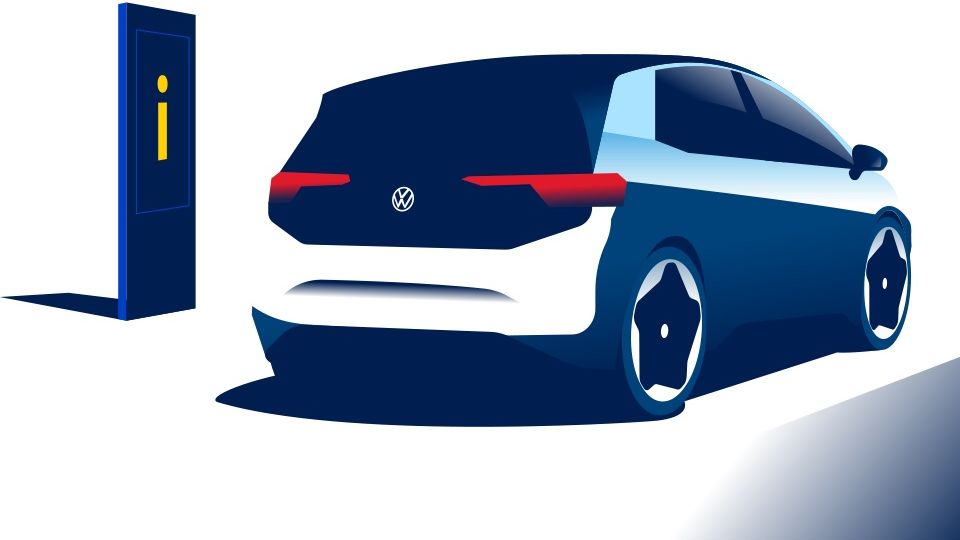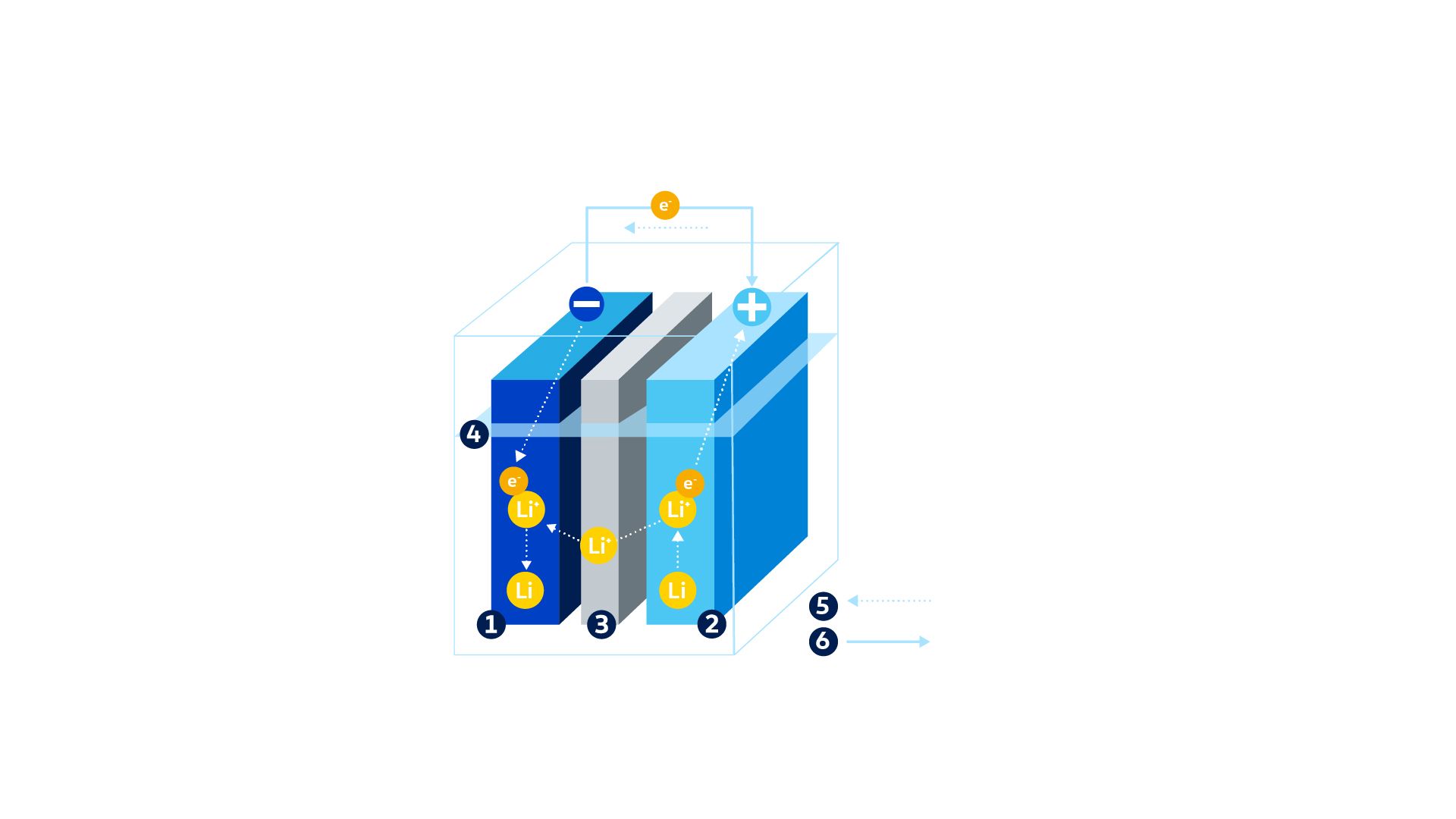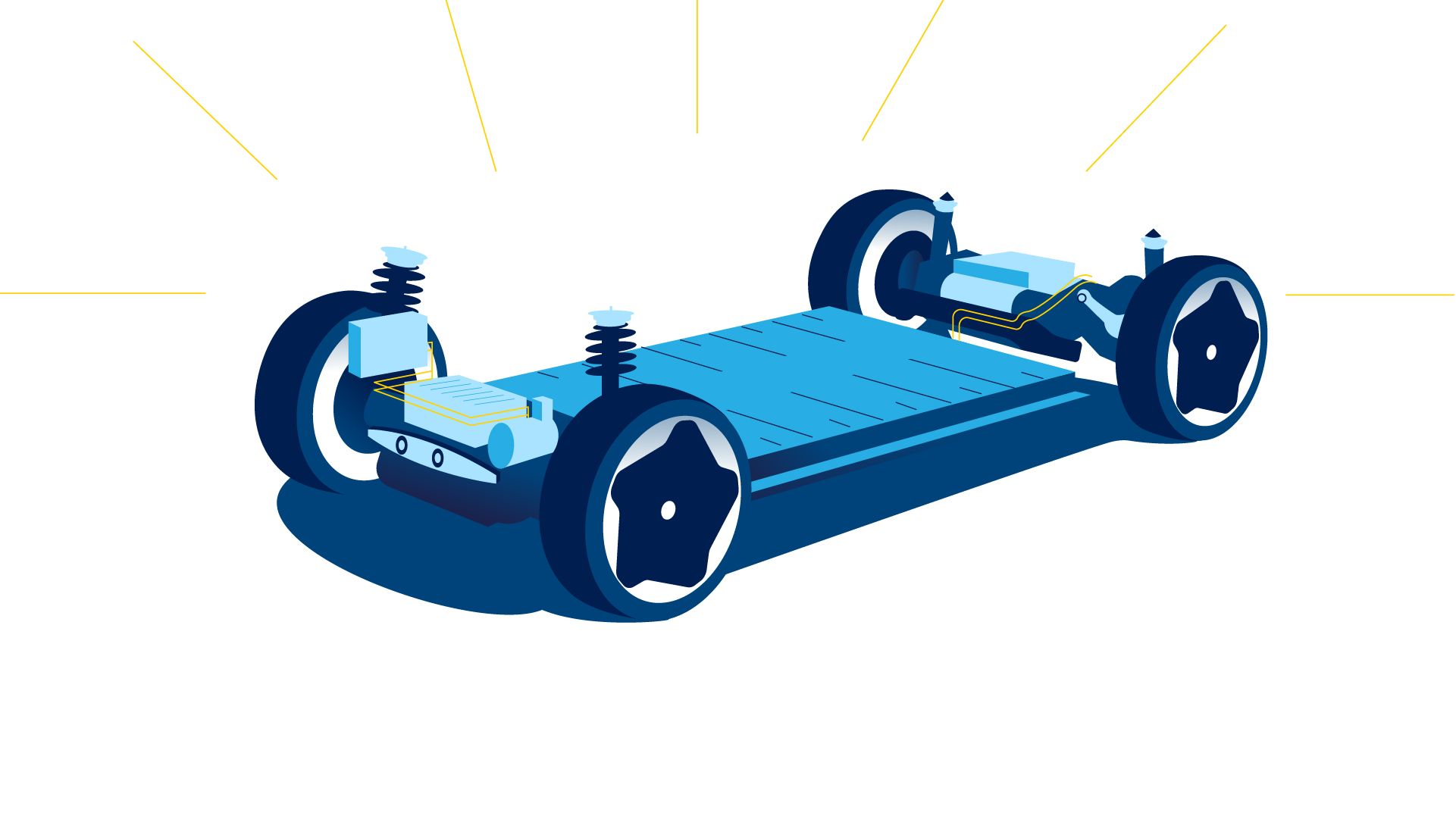Explore the cutting-edge technology powering our electric vehicles.
Discover insights into our innovative battery technology and safety, utilization of the MEB platform,
and efficient battery charging.
Simply explained: the ID. Family battery system
The ID. Family's newly developed modular electric drive matrix (MEB) has been specifically designed for electric vehicles.
The heart of the system is a fast-charging battery system consisting of different numbers of battery modules, depending on the desired range. Each of these modules contains 12 lithium-ion battery cells. The cells utilised in the MEB have a "pouch cell" design. They consist of multiple stacked or folded active layers enclosed by a flexible outer film. This makes pouch cells highly flexible in terms of their shape and optimally adaptable to the specific requirements. In addition, their smooth surface also provides high heat dissipation.
Battery system of the MEB electric platform as pictured:
Battery cells (1), Battery modules (2), Battery system (3), Battery (4), Drive system (5).
Simply Electrifying: The lithium-ion battery
A lithium-ion battery cell always consists of four components: anode, cathode, separator and electrolyte. During charging, the lithium ions travel from the cathode to the anode and are stored there. The electrical energy from the power grid is converted into chemical energy.
During the discharging process - for example, to power the electric motor - it works the other way round: the lithium ions now travel from the anode back to the cathode and convert the chemical energy back into electrical energy.
Five main raw materials are needed to produce lithium-ion battery cells: a compound of cobalt, nickel and manganese for the cathode (this structure helps to store the lithium charge carrier), graphite for the anode and, of course lithium, which is contained in the electrolyte.
Lithium-ion battery cell components as pictured:
Anode (1), Cathode (2), Separator (3), Electrolyte (4), Charging (5), Discharging (6).
The Modular Electric Drive Kit (MEB)
Whether it's in a city car, SUV or spacious seven-seater, the modular electric drive kit - known as the MEB - offers you everything you need for the future of driving.
That's because this newly developed vehicle platform is designed specifically for electric cars. The key benefit of this is that the MEB can be used to make the most out of the possibilities offered by the technology.
For you, this means more space, range, comfort and convenience.
More space in which to blossom.
Volkswagen has rethought electric mobility from the ground up. The need for a combustion engine, gearbox, transmission tunnel, tank unit and exhaust system has finally been eliminated. This is good news for you as well as for our engineers and designers. As a result, the wheelbase becomes larger, the overhangs are shorter and the small electric motors sit directly on the axles themselves.
This not only looks more dynamic, but also provides the perfect base for every vehicle - from a compact car to a van. And you experience a whole new sense of space and have more room for yourself, your passengers and your luggage.
The perfect power system.
At the heart of the ID. family lies its fast-charging battery system, which is protected and integrated in the floor of the vehicle to save space. This lowers the centre of gravity and creates a better distribution of weight so that you can enjoy exceptionally well balanced and dynamic driving.
The battery can also be customised.
If, for example, you don't necessarily need a large range because you do a lot of driving in the city, a small battery will be fine. This also lowers the price of the car.
If, on the other hand, you need large amounts of power for long distances, simply choose a vehicle with a bigger battery.
The three golden rules to looking after your battery
It's relatively easy to keep your high-voltage battery well-maintained. If you adhere to the three golden rules, then you have already done the most important thing to maintain a high range for your vehicle.
- Please do not charge the vehicle to more than an average of 80% during daily short-trip usage.
- If the vehicle is not moved for more than 12 hours, it should be charged between 30-80% of capacity.
- To fully charge a vehicle (100%), use a charge timer in the charge manager and then drive off immediately after charging is completed.
Actual charging times will vary depending on various factors, including the type of charger used, the level of charge in the battery, the age type, condition and temperature of the charger and the battery, the power supply, ambient temperature at the point of use and other environmental factors. Charging times will also be affected by the charging curve (for example, once charging passes 80%, charging will slow to protect the battery’s longevity) and will be longer if battery temperature activates safeguarding technology.
Keeping the battery of your electric car cool
Electric cars aren't keen on extreme temperatures - like most drivers. Therefore, clever management is indispensable for optimum battery life and capacity.
Good thermal management protects the battery
As with combustion engine vehicles, the outside temperature directly impacts the range of the electric motor. That's why an effective thermal management system, as is used in Volkswagen's electric ID. models, is especially crucial for electric cars. The term 'thermal management' covers all the processes that control heat flows in vehicles. To keep the batteries of electric cars and hybrid vehicles within an ideal temperature range, they need to be cooled under hot weather. Not only does this ensure the maximum range, but it also increases battery life. A comfortable temperature for effective operation is between 20 and 40 degrees.

Factoring in battery composition
This is because of the composition of the cells in the battery, which are a chemical mixture of lithium, cobalt or nickel, graphite, copper, and aluminium. During the charging process, lithium ions are transported from one pole (the cathode) to the other (the anode) by a conductive fluid between the poles. Like any other material, this electrolyte has an optimum temperature range within which it performs best. Both very low and very high temperatures can therefore affect battery capacity.

Simple tips for high temperatures
Even with an efficient heat management system, some simple steps to take the heat off the battery will not do any harm.
Follow these tips to protect your car battery easily and effectively:
- Air-cooled batteries are more sensitive to high temperatures than liquid-cooled ones.
- Therefore, electric cars with air-cooled batteries should be parked in a cool spot whenever possible.
- At high outdoor temperatures, parking your electric car in the garage or in the shade, when possible, is generally recommended.
- This keeps the interior cool, and the ground under the vehicle doesn't get as hot - and so neither does the battery.
- To increase service life, it's advisable not to charge the battery fully when temperatures are high, but just to a level of about 80 percent.
- Charge the electric car as slowly as possible in very hot weather.





